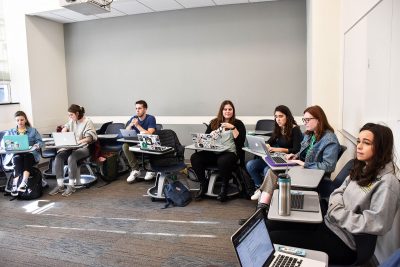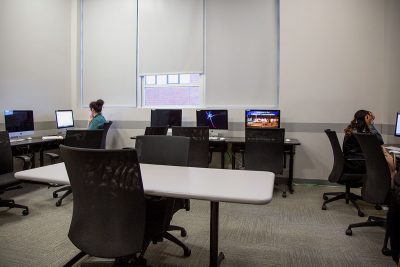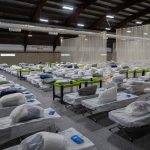
By Audrey Martin, Lexi Matthews and Conor Kelley
On the first day of her Motion Picture Editing class, film and television student Caroline Barry was going to start her classwork of importing, rendering and editing footage. Instead, Barry and her classmates spent upward of three hours downloading software onto their laptops.
“We had to input all the same footage and programs so we’d all be on the same track,” the junior said. “Instead of taking a half an hour like our teacher expected, it took longer than the class itself.”
Barry and her peers are among the first wave of students to experience the pros and cons of the Bring Your Own Device (BYOD) policy now in effect at Boston University’s College of Communication.
Last spring, COM announced that fall 2018 would see the removal of all but one of its computer labs in the COM building and the complete shift to the BYOD policy for students. The department claimed that the expenses required to maintain the 11 computer labs in COM had become unjustifiable, since more and more students were already bringing their own devices.
Additionally, the Adobe licenses connected with computer labs are no longer necessary, as a deal BU made with Adobe last year now allows students to download the Adobe Creative Cloud suite onto their personal devices for free.
Now, only one computer lab in Room 338 remains open, with 13 iMacs available for use inside.
Some students have had trouble downloading the Creative Cloud and other software, specifically Avid Media Composer, COM Director of Technology Brad Fernandes said. The initial version of Avid COM posted was not compatible with certain iMacs, he said, but students have primarily faced issues such as full hard drives and bad media management.
“So far, we’ve had surprises that we didn’t anticipate, and we anticipated things that were not really problems,” Fernandes said.
Over the summer, Fernandes said, COM purchased 35 new loaner Macbook Pro laptops using its technology budget for students to check out for classes. COM lends an average of 5.5 laptops per day, he said.
“If anything, right now we’re showing that maybe we bought too many,” Fernandes said.
The new laptops, having been recently purchased by COM, were in good condition at the start of the semester and showed no signs of damage or overuse.
Students can check one out, along with a charging cable and mouse, for three to four hours inside the COM building seven days a week. Students must present their BU ID to the COM technology office and disclose what class they require it for in order to check one out.
Overall, aside from the overbuying of loaner laptops and some “hiccups” with students installing the new software, Fernandes said he thought the new policies were going well.
“I think we overthought some things over the summer and some of the areas we didn’t know,” he said, “but that’s going to be the case with everything [with] 3,000 students here at COM.”
Along with students, COM professors who either taught classes in the computer labs or currently rely on software that used to be available in the labs have developed their own opinions on the transition.
Peter Smith, a senior lecturer of photojournalism, said he began advocating for a shift from computer labs to a BYOD policy five years ago to keep up with industry standards.
“Journalists work on laptops,” Smith said. “It’s like a photojournalist trying to do a job without a camera. You can’t be a journalist now without a laptop.”
Stephen Hume, a sophomore studying film and television, said that even before the policy, most students had their own devices and that the removal of the desktops could allow for an improved use of COM’s finances.
“By limiting the amount of money that was previously put into computer labs and stuff like that,” Hume said, “COM has the freedom to allocate more funds to other programs and other facilities like the studios in the communications building.”
Hume said that the adjustment to working with smaller screens is also something that students comfortable with regular desktop use are acclimating to.
“I know for some people, editing on a laptop and doing things like that on a smaller screen is not the most ideal situation, but I personally can’t complain,” Hume said.

Several professors of lab classes said the removal of the iMac desktops in the classrooms has led to technological inconveniences, which, along with software issues on students’ laptops, have wasted class time on troubleshooting.
Susan Walker, a professor of journalism who teaches Reporting With Audio and Video, said the transition forced her and many other professors to recalibrate their approach to classes, particularly with film and video editing.
“It’s frankly turned about an hour of a three-hour class into a Genius Bar experience where I have to stop down in my teaching and help someone whose computer either isn’t updated or doesn’t have the right kind of computer,” Walker said. “I’m really supposed to be teaching visual literacy, not technical support.”
Students outside of COM have found challenges in the change as well. Natalie Bennett, a junior in the College of Arts and Sciences who works for BUTV10, said she has experienced new obstacles in her extracurricular this year.
“We have to figure out which rooms are open that do have a computer in order to do video editing and which rooms don’t,” Bennett said. “… People have to consider their options more, before you just always [knew] there were computers available for use.”
Some faculty like Joseph Lippincott, a lecturer in photojournalism, do not see the benefit of this change for students.
“If this were a school that cost $5,000 a year, it would be fair,” Lippincott said. “But I don’t think it’s fair for what students are paying.”
Despite the rocky start many classes had in acclimating to the use of laptops, Walker said she supports students’ ability to complete their assignments anytime and anywhere, instead of having to wait for COM’s accessible hours.
The transition has also been well-assisted by COM’s technology department, Walker said.
“The guys on the third floor should really be thanked because they’re doing yeoman’s work of one-on-one support,” Walker said.
Anne Donohue, a journalism professor, said she wished the removal of the labs had been more gradual rather than all at once and that at least one more computer lab had remained.
Now that there are no allocated lab classrooms, Donohue said, the university matrix has sent former COM lab classes either outside of the COM building or into other rooms, both of which may not be ideal for certain classes.
Donohue’s radio class was originally scheduled to be in a College of General Studies classroom, but the lack of proper audio playback in the classroom prompted her to request to be moved back to COM.
Donohue said there are pockets of closet-sized rooms scattered throughout COM that have desktops in them, unknown to many students.
“If you know where the bodies are buried, then you’re ahead of the curve,” Donohue said, “because there are few remaining computers.”
Throughout the COM building, a majority of classrooms feature long tables with outlets fixed into the tables themselves or traditional individual desk setups with outlets dispersed across the walls of the room.
Most classrooms featuring the long table setup have a one-to-one or higher outlet-to-desk ratio, while classrooms with individual desks were found to have much fewer outlets on average.
Outlets are a key part to making the transition a success, Smith said. If a room has inadequate outlet access, he said it then falls on the professors to take it up with COM.
“That’s up to the faculty,” Smith said. “Are they all hitting it a hundred percent? It sounds like maybe a couple aren’t … I would say most of them probably are.”
In addition to 338, Rooms 321, 321A and B27 all contain at least one iMac in some part of the room.
As for the old lab computers, Fernandes wrote in an email that the newer, “thin style” iMacs from the labs are being reassigned to COM faculty and staff, the Communication Research Center and the COM student lounge.
Roughly 40 iMacs purchased before 2011 are past their life cycle and will be recycled by BU’s contracted electronic recycling vendor, Fernandes wrote.
Fernandes said that the university pays the recycling company to “make sure that everything is recycled responsibly.”
The process will take place during an upcoming break in classes, Fernandes said, so students are not disrupted by large carts in the hallways, and so the process can be done all at once instead of over time.
There is no set date for the recycling process yet.
Mike Reddy contributed to the reporting of this article.
This is an account occasionally used by the Daily Free Press editors for posts with multiple authors or otherwise for special circumstance publications. See authorship info on the byline at the top of the page.




